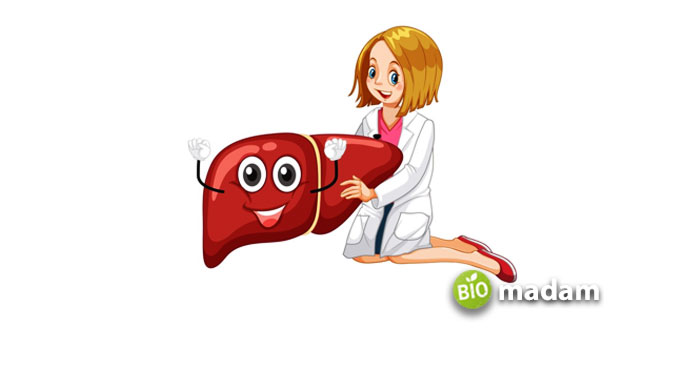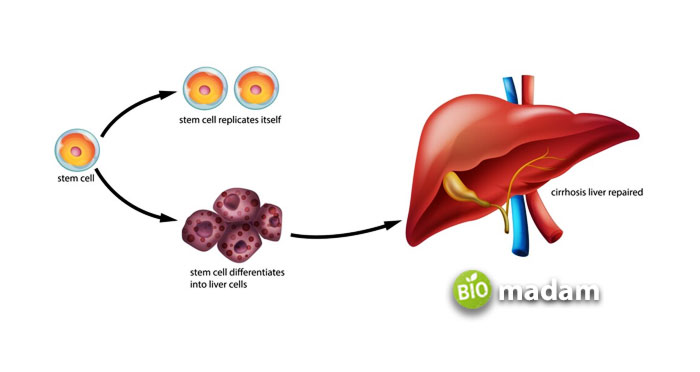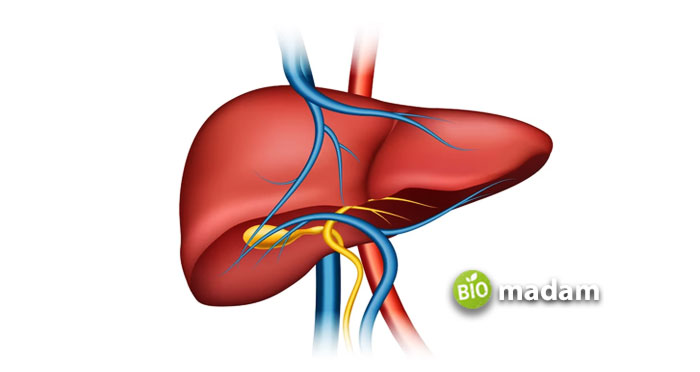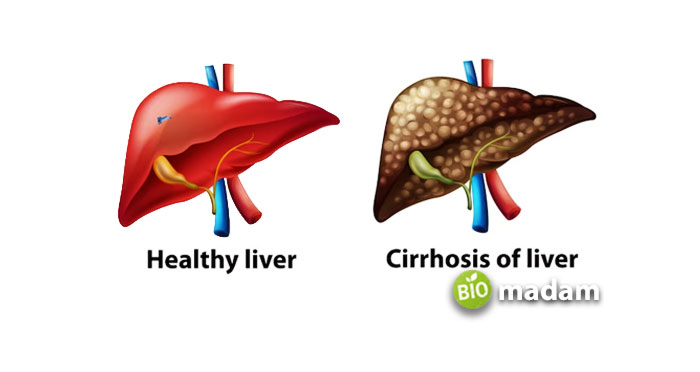There are different types of eukaryotic organisms surrounding our habitat and ecosystem, with human beings being the prominent ones. A human body is composed of millions and trillions of cells that accumulate to make tissues. Different types of tissues combine to make large organs stipulated for multiple functions. There are several organs in a body, including the heart, kidneys, right and left lungs, stomach, intestines, and liver.
The liver is the largest internal organ maintaining overall health. It is located on the right side of the abdomen, just below the diaphragm, and is protected by the ribcage. However, there is a condition called “situs inversus,” in which the liver is seen to be on the left side. There are almost 500 functions performed by a liver that will be discussed below.
What is a Liver?
Besides being the largest organ, the liver also serves as an exocrine gland in the body. It is a dark reddish-brown, wedge-shaped structure about the size of a football. However, each individual’s liver can vary depending on height and weight. It is an essential organ for the survival of a human. It is the only organ with the ability to regenerate if damaged by an infection or disease. So, if a portion of your liver is damaged or removed, the body will make changes to grow the remaining part and restore it. Besides, it has a vast network of blood vessels, thus, making it one of the most complex organs in the body.

A liver comprises cells known as hepatocytes, responsible for its metabolic and synthetic functions. There are two main pathways through which a liver caries blood, i.e., hepatic artery and hepatic portal vein. The artery carries oxygen-rich blood from the heart, whereas the portal vein carries nutrient-rich blood from the small and large intestines, stomach, spleen, and pancreas toward the liver. Moreover, the study of the liver is called hepatology that deals with the anatomy, physiology, and pathology of the liver, gallbladder, and pancreas.
Main Functions of Liver
As discussed, the liver is involved in hundreds of different functions. Let’s discuss the primary ones below:
Helps in Metabolism
It is the leading site of metabolism. Thus, the liver is involved in processing nutrients, like carbs, proteins, and fats, from the food we ingest to convert them into energy. Not just this, but after the complete metabolism, the food is distributed throughout the body by the liver. Moreover, most antibiotics and analgesics are metabolized through the liver.
Regulating Blood Sugar Levels
The liver is essential to regulating sugar levels in the blood and plasma. It functions to store glucose and produce glycogen. These are the forms of carbohydrates that play a direct role in providing energy to the body. Glycogen can be broken down and utilized as glucose when needed.
Helps Detoxify Harmful Substances
The liver has the ability to filter out harmful substances from the blood. It contains special Kupffer cells, also called resident liver macrophages that work to digest and destroy toxic particles or any invading microbe like viruses or bacteria. Furthermore, it detoxifies drugs, alcohol, and other toxins. A liver metabolizes these substances into less harmful forms that can be excreted from the body through urine or feces.
Helps in Bile Production
Among many vital fluids, this bile is majorly involved in absorbing nutrients from the small intestine. The liver functions to produce this bile, so it can further perform its verified job. In the small intestine, the bile helps absorb fat-soluble vitamins. Besides, it also breaks down fats into small particles.

Synthesizing Proteins
Different types of proteins are present in a body to perform several functions. A liver plays its part by synthesizing or producing essential proteins, like protein Z, protein C, plasminogen activator inhibitor, protein S, etc. These are vital to immune functions, blood clotting, and maintaining body fluid balance.
Acts as a Storage Site
The liver is the storage site for essential body components like vitamins, minerals, and other micronutrients. These are released by the organ when required for particular functioning. Moreover, the liver is also seen to store blood, which is released into the bloodstream when necessary.
Functions to Improve Immunity
Immunity is vital for human survival, and the liver plays an essential role here. It is naturally positioned to capture foreign antigens or pathogens when they enter a body. It contains specialized hepatic immune cells to help remove bacteria and other harmful parasites from the blood. Thus, it wouldn’t be wrong to say that the liver functions to prevent the growth of various infections and diseases.
Regulating Hormones
Another important function performed by the liver is regulating the levels of hormones in the body to avoid emotional imbalances. It regulates thyroid hormones, sex hormones, cortisol, insulin, etc. The activation or inactivation of these particular hormones is controlled throughout the liver.
Structure of Liver
A liver is typically divided into two lobes; the right and left lobes. However, two more lobes just under the right lobe are also present, called “accessory” or “superficial” lobes. Each has its own hepatic veins, ducts, and blood supply, to work together and provide proper liver functioning. It’s necessary to understand the anatomy of the liver to diagnose any liver disease or disorder.

- Right Lobe: It is the heaviest of all four lobes, accumulating almost two-thirds of the liver mass. The right lobe is further categorized as anterior and posterior lobes, distinguished by a hepatic vein.
- Left Lobe: It is comparatively smaller than the right lobe and is subdivided into two essential segments. One is called the left lateral segment, whereas the other is termed as left medial segment. The blood coming towards the left lobe is from the stomach, esophagus, and pancreas through the hepatic portal vein.
- Caudate Lobe: It is a triangular-shaped, small lobe at the posterior side of the liver and between the left and right lobes. It is separated by the ligamentum venosum from the left lobe and by the inferior vena cava from the right lobe.
- Quadrate Lobe: It is also a small but square-shaped lobe located near the gallbladder. A quadrate lobe is separated from the left lobe by the ligamentum teres and from the right lobe by the porta hepatis.
Health Conditions Associated with Liver
Many infections or underlying health conditions can affect your liver functioning. A few are discussed below:

Hepatitis
It is the inflammation of the liver that is commonly caused by viral infection. This type of disease has further categories, such as hepatitis A, B, and C. It is typically transmitted from infected blood, sharing syringes or needles, sexual contact, allergic reactions, etc.
Liver Cancer
The formation of cysts or tumors is another common cause affecting liver functioning. There are many causes of liver cancer, but the most common is cigarette smoking.
Cirrhosis
It is a medical condition that occurs after long-term damage to the liver. There can be many underlying causes of liver cirrhosis, such as hepatitis B and C and excessive alcohol intake.
Besides these three main chronic liver conditions, there are many others, so it’s vital to take proper care of your health to avoid liver damage.
The Bottom Line
The liver is the largest organ existing within the human body, responsible for several functions. It is a platform for plasma protein synthesis, like clotting factors and albumin. Similarly, the liver is held accountable for detoxification, metabolism, and regulating immunity.
FAQs
What is the normal liver level?
You can easily detect the normal liver level in a blood test. Its normal range includes ALT. 7 to 55 units/liter and AST. 8 to 48 units/liter.
Which fruits are best for the liver?
There is a range of liver-friendly fruits, for e.g., grapes, apples, lemons, and oranges. Try to consume these fruits in the form of juices to get more antioxidants, thus improving liver function. You can even freeze fruits like grapes and lemons to use them later.
How to improve liver function?
A human can take essential steps to improve its liver function, such as maintaining a healthy weight, avoiding intake of toxins, exercising regularly, and taking a diet balanced with macro and micronutrients. Besides, you can seek professional help if you think you’re exposed to contaminated needles or experiencing any signs of improper liver functioning.
What are the warning signs of a damaged liver?
There could be numerous signs and symptoms of a diseased or damaged liver. These may include leg swelling, severe abdominal pain, dark-colored urine, itchy skin, rashes, fatigue, nausea, and vomiting.
What is a liver function test called?
Alanine Transaminase (ALT) is a general test to check normal liver functioning. It is usually performed to evaluate if there is any acute liver disease or condition affecting liver health, such as hepatitis.

Hello, I would like to introduce myself to you! I am Chelsea Rogers, an experienced blog writer for science articles, holding an MPhil degree. My enthusiasm to grab the best knowledge, let it relate to botany, zoology, or any other science branch. Read my articles & let me wait for your words s in the comment section.

